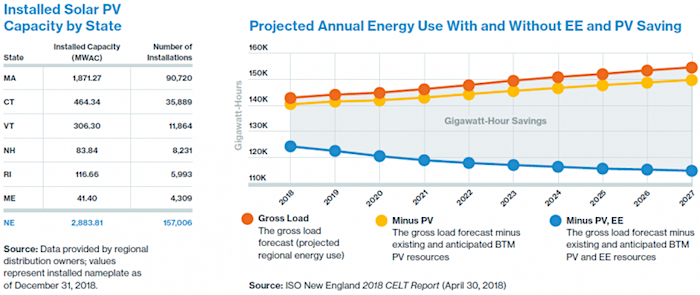The nonprofit independent system operator that manages the region’s electric grid estimates that it’s in a good position to meet the region’s power needs this winter, when energy use tends to spike during during chilly months.
However, to make it all work the region may need to burn large amounts of fuel oil.
It is expected that New England energy consumers will use 20,476 megawatts during regular winter conditions, and that bumps to about 21,173 MW during extreme cold, a news release from ISO New England states.
The organization said current power plants are “sufficient to meet the forecasted peak demand under both normal and extreme weather conditions.”
This will be the first winter without the Pilgrim Nuclear Power Station in Plymouth, Mass., which went offline earlier this year. It had a substantial 690 MW output, or about 14 percent of the state’s total consumption. That’s comparable to when Vermont Yankee went off-line in 2014, resulting in the loss of 600 MWs.
According to ISO’s Matt Kakley, the lost power generation has long been anticipated.
“Pilgrim’s owners announced their intention to retire the plant in fall 2015,” he told True North in an email. “Since that time, the region’s wholesale markets have responded, and new resources have come online. Resources newly available this winter include three dual-fuel plants that can run on either natural gas or oil, as well as new solar and wind resources.”

(The above graphic from ISO shows the impact of energy-efficiency measures and behind-the-meter solar photovoltaic.)
Another obstacle in winter is the region’s natural gas pipeline capacity. When demand peaks, New England can’t always get all the gas it needs, and power plants must much switch over to fuel oil, which costs more for ratepayers and is twice as carbon-intensive.
“During these times, natural gas pipeline constraints can limit the availability of fuel for natural-gas-fired power plants,” the ISO New England news release states.
Kakley explained how the cold weather affects power plants.
“As in past years, we expect that periods of extremely cold weather could limit the availability of pipeline gas for power plants,” he wrote. “The ISO estimates that up to 4,500 megawatts of gas-fired generation could be at risk of not being able to access fuel during these cold periods.”
Bitter cold, in addition to increasing grid demands, can physically inhibit the availability of both oil and liquefied natural gas.
“In those instances, the ISO has procedures in place to maintain reliability, including importing emergency power from neighboring regions, and asking businesses and residents to voluntarily conserve electricity,” the organization states.
While behind-the-meter solar photovoltaic (PV) systems are helping to relieve demand, that only kicks in when the sun is out. The grid experiences its highest demand at night, in coldest temperatures.
Critics say green policy driving up carbon emissions
Matt Cota, director of the Vermont Fuel Dealers Association, told True North that electric demand coupled with the loss of carbon-free nuclear power and constricted natural gas contributes to an increased use of carbon-intensive fuel oil.
He explained that when Vermont politicians push to electrify home heating with cold-climate heat pumps, and transform transportation with electric cars, grid demand increases, leading to greater use of fossil fuels.
“So all those electric heaters that buzz on in January, that everyone feels all warm and fuzzy about because they think they are doing a green good, they are all being powered by fossil fuels,” he said. “It’s much more efficient for that heat to be derived from fuel combusted inside the home rather than done hundreds of miles away where you have tremendous inefficiencies and line loss delivering fossil fuel power to Vermonter’s homes.”
Cota noted how during just one 10-day cold stretch in January 2018, ISO burned more fuel oils to keep the power running than the whole state of Vermont uses in an entire year.
Now, with the closing of another nuclear plant in the region, the natural gas plants may face their most demanding season yet.
“This is the irony,” Cota said. “While those advocates for closing nuclear power are cheering with the closing of Yankee and Pilgrim, the reality is that this is only going to ensure that natural gas and heating oil is used evermore in creating electricity.”
Willem Murray, in an article published on RStreet.com, made similar comments about environmentalists who seek to restrict gas pipelines: “For those keeping score, fuel oil emits double the carbon dioxide and many times the sulfur and particulates matter as natural gas, so the idea that being against pipeline capacity can increase harmful emissions instead of decreasing them is an interesting plot twist,” he writes.
Michael Bielawski is a reporter for True North Reports. Send him news tips at bielawski82@yahoo.com and follow him on Twitter @TrueNorthMikeB.



No pipe line, no necular plants.more emisions? The “greenies” shoot themselves in the foot again. When will these folks stop meddling in areas where they don’t have clue? Unfortunately, it’s not going to happen.
3-2-1.….Now lets protest!!!!!!!!!!!!!!!!!!!!!!
So sad that the supposedly carbon-conscious environmental groups 1) pushed for closure of both Yankee and Pilgrim and 2) have done nothing to prevent the risk of other shutdowns of hydro or nuclear power. When they want wind and solar, their hair is on fire; when someone else suggests zero-carbon hydro and nuclear, suddenly the climate problem isn’t THAT serious because other concerns must be addressed first.
I want all the “green” worshipers to lead the way by going without electricity when the sun doesn’t shine or the wind doesn’t blow. — It won’t take long before they wise up and start thinking like normal people.